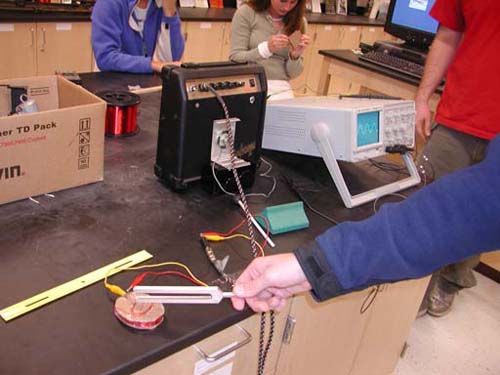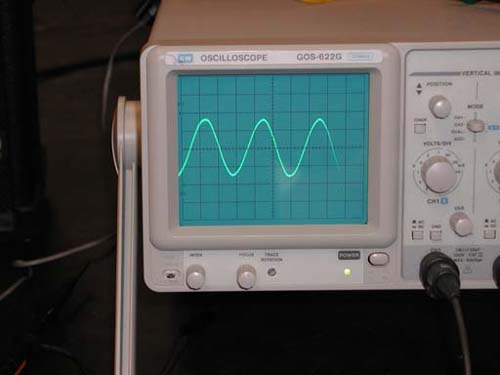To test the pickup, you need the following:
- A guitar amp, with guitar connector cable
- A metal tuning fork (works just like a metal wire)
- Optional: A microphone and an oscilloscope
Plug the guitar connector cable into the amp, and bring the other end of the cable to your pickup. Attach the wires to the plug as follows:

Attaching wires to plug.
It does not matter which wire goes to which end of the plug; they are interchangeable. Make sure the wires are firmly attached; tape them in place, if necesary. After this, turn on the amp. Hit the tuning fork on something and hold it near your ear; you should hear a pure tone. Then, hit it again if it has stopped ringing, and hold it over your pickup:

Testing the pickup using a tuning fork.
If you have a working coil, you will hear the same tone coming from the amp's speaker. If not, make sure you have a good connection between the pickup and the amp, and that the amp is working; if all of these are the case, you probably broke a wire somewhere; there's not much to do but start over from scratch and hope that you get one continuous wire this time.
If you have a microphone and an oscilliscope, connect the oscilliscope to the microphone and put the microphone in front of the amp's speaker. You can see this setup in the background of the previous picture. Then, turn on your oscilliscope and hold a vibrating tuning fork near the pickup again. You will see a perfect sine wave on the oscilliscope:

Sine wave on the oscilliscope.
This wave is a graph of voltage versus time; the microphone converts pressure changes to voltage; thus, it represents the graph of pressure vs. time at the speaker. This clearly illustrates that sound is transmitted by waves. Incidently, try picking up other sounds with the microphone and looking at them on the oscilliscope; you'll find that few sounds look exactly like the tuning fork. The frequency of the wave that you see on the oscilliscope represents the pitch of the note being picked up; the shape of the wave represents the texture and the tone of the note.
Once you have finished with testing your pickup, drill a small hole in your guitar body around the section where your pickup should be glued (see Building Frame section), so that the wires can run through to the back of your guitar. After that, run the lead wires through the hole and glue the pickup in place, so that the bar magnet inside the pickup runs underneath, and perpendicular to, all four strings:

Bar magnet inside the pickup.
The next step is to design the circuitry of the guitar. Click here to go directly to the first circuitry page; click here to return to the designing-pickup page.
